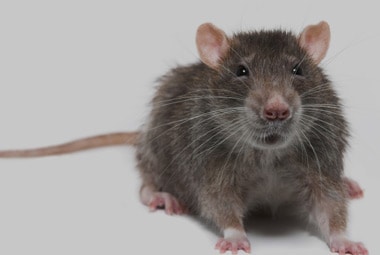
Norway rats are large rodents; and since they are rodents, they have large front incisors that are continuously growing. In order to prevent overgrowth, they continuously gnaw on objects. Inside homes, businesses, and other buildings their chewing can cause major damages. Norway rats are commensal rodents. This means that they have come to somewhat rely on people for their food, shelter, and water needs.
| Pest Identification | |
|---|---|
| Recognition | Adult Norway rats have a body length of 7- 9 ½ inches and a tail length of 6-8 inches. Their tail is darker-colored on top and lighter-colored underneath; they have shaggy or ruff appearing fur that is brown in color and is scattered with black hairs. Their belly is has a lighter coloring. The Norway rat has a blunt nose, small ears, and protruding black eyes. Their droppings are dark and rod-shaped with blunt ends. |
| Biology | The Norway rat reaches sexual maturity between 2 and 5 months of age. When living indoors they don’t have a specific breeding season and will reproduce year-round. When living outside their reproductive season is generally in the spring and summer. After the Norway rat mates, there is a gestation period of 22 days. Norway rats can produce small litters (4 pups) or very large litters (20 or more pups). Each female will produce an average of 4-7 litters per year. Norway rats carry and transmit a lot of diseases including plague, jaundice, rat-bite fever, trichinosis, and salmonellosis. They will also introduce other pests (and the diseases that they carry and transmit) into your home like fleas, ticks, and mites. |
| Habits | Norway rats are known for being poor climbers and are typically found infesting ground levels of homes, businesses, and other buildings. Even though Norway rats like to live with or near people in order to feed on things like fish, dry cereal, pet food, and garbage, they are shy and reclusive and are rarely seen by people, especially during the day. Norway rats typically suffer from neophobia, (fear of anything new or unfamiliar) making trapping and baiting more difficult, because when a new bait or trap is introduced to their environment, the rat will not associate with the trap or bait until it feels comfortable with it. Norway rats are nocturnal and during the day will hide in basements, under piles of debris, in crawl spaces, and in wood piles. Norway rats have very poor eyesight so they use their whiskers in order to feel their way around their environment. They will follow the same path or “runway” from their nest to food source, leaving behind grease marks and dirt from their fur along walls and other objects. Norway rats have very powerful jaws and teeth that can chew through and damage almost anything including pipes, flooring, and drywall. Structural damages from rats can lead to fires and water leaks. They will also damage personal items like furniture and clothing; they will also contaminate your property, pantry areas, food prep areas, and/or inventory with their urine and feces. Norway rats are known to build burrows under sidewalks, decks, garages, sheds, and the foundations of buildings. |
| Prevention | Along with putting into place a year-round pest control plan to help stop problems with rodents and other pests, there are some things that you can do as a homeowner to help prevent a Norway rat infestation in your home. Limit the amount of stuff and debris that you store in your home’s basement, storage areas, or outside on your property. Ensure that outdoor trash cans are regularly emptied and have tight-fitting lids on them. Pick up dishes of uneaten pet food and store pet food in plastic or metal containers with tight-fitting lids. Fill in any holes that are found around the outside of your home especially along lower levels. Be sure to inspect the actual foundation as well and seal any cracks or crevices present there. |
| Professional | Norway rats are considered to be both dangerous and damaging pests; they carry diseases and have the ability to destroy homes and businesses and the content stored within them. Rottler Lawn & Pest Solutions can provide safe and effective services to get rid of Norway rats with our rodent exclusion services. Rottler’s rodent exclusion services provide our customers with the following: inspection services to correctly identify the species of rodent infesting your home, identification of entry and exit points, sealing of entry and exit points, identification of items that are drawing rodents to your property, and the installation of baits and/or traps as needed. |

